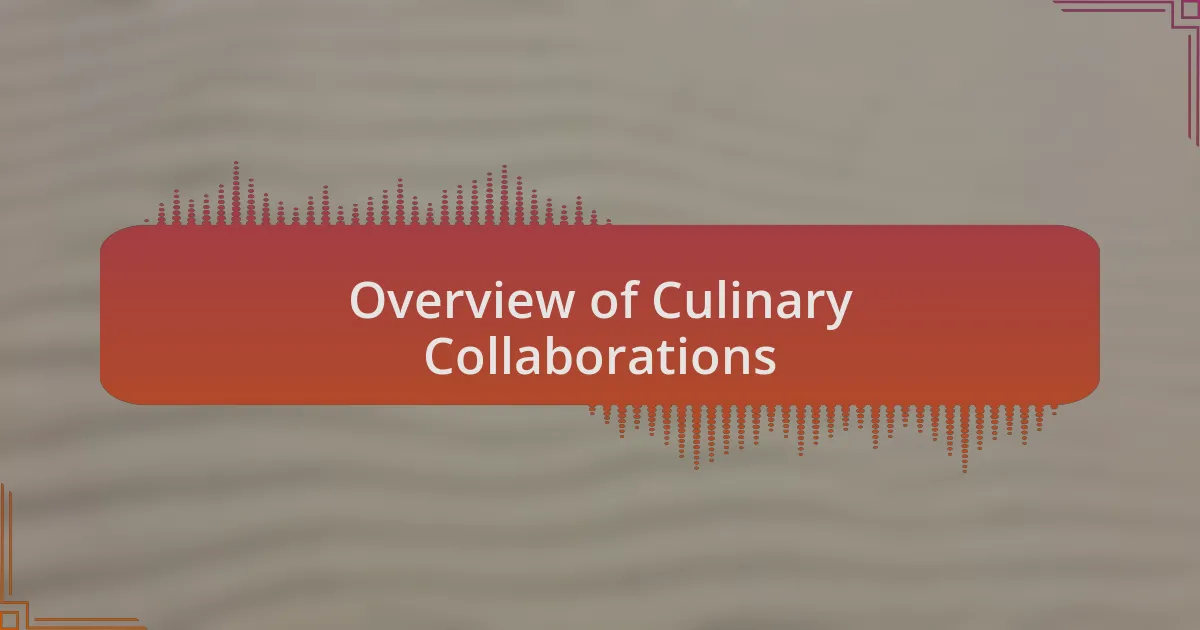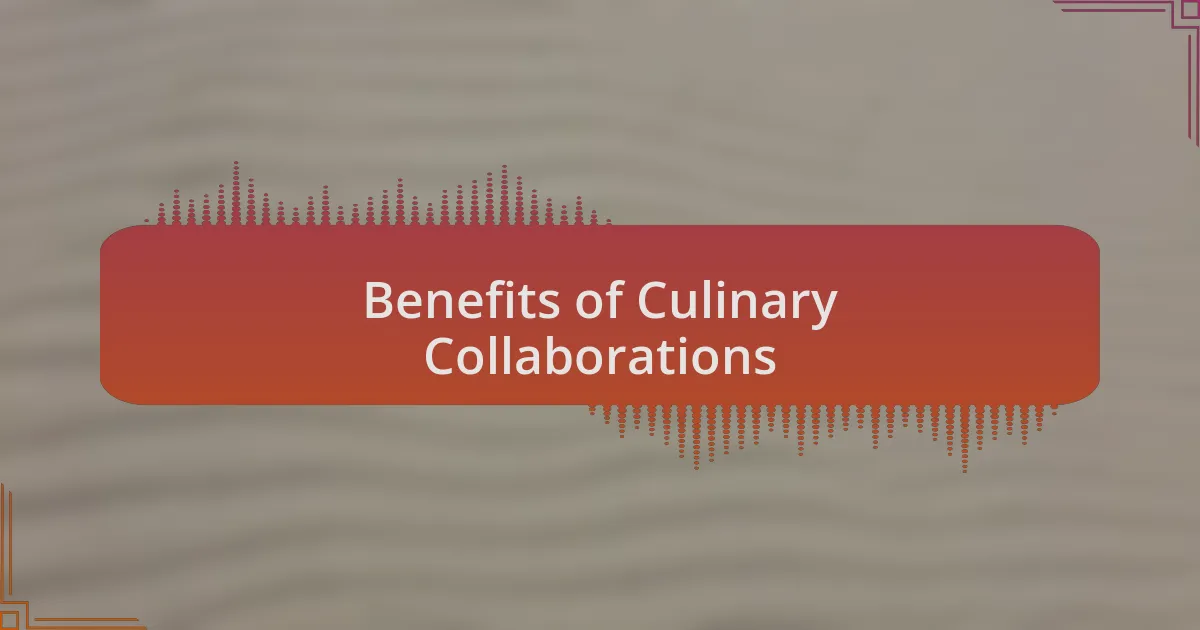Key takeaways:
- Culinary collaborations blend diverse skills and cultural traditions, enhancing the dining experience and promoting sustainability through local ingredients.
- These partnerships foster community among chefs and create memorable culinary events, showcasing innovative fusions of flavors.
- Effective communication and clearly defined roles are essential for successful collaborations, allowing creativity to flourish and enhancing the final product.
- Unique culinary experiences, like cooking classes and farm-to-table dinners, deepen appreciation for food and its cultural significance.

Overview of Culinary Collaborations
Culinary collaborations are a symphony of flavors, where chefs unite their unique skills and cultural backgrounds. I remember attending a vibrant food festival where local talents teamed up to create dishes that celebrated both tradition and innovation. The energy was palpable, and the thrill of tasting new combinations sparked a deeper appreciation for regional cuisine.
In many cases, these collaborations serve as a bridge, connecting diverse culinary worlds. Have you ever tasted a dish that combines your favorite local spices with international techniques? I once tried a jerk chicken prepared by a French-trained chef; it was a revelation! This melding of styles not only enhances the dining experience but also tells a story about unity and creativity.
Moreover, culinary collaborations often emphasize sustainable practices and local ingredients. One inspired chef I met decided to partner with local farmers, showcasing the best produce of our region in their new restaurant. I was moved by the philosophy behind it: by supporting local, we ensure that our culinary future is vibrant and sustainable – a lesson that resonates beyond the plate.

Benefits of Culinary Collaborations
Culinary collaborations bring a delightful fusion of flavors that not only tantalize our taste buds but also create memorable experiences. I recall a particular evening at a resort where a renowned pastry chef and a local barbecue expert teamed up for a dinner event. The unexpected pairing of smoky grilled desserts was a game-changer – it left us all buzzing with excitement and eager to share our discoveries. How often do we get to witness such daring culinary experimentation?
Additionally, the collaboration process fosters a sense of community among chefs. When I participated in a workshop where seasoned chefs mentored younger culinary enthusiasts, I saw firsthand how knowledge-sharing ignites passion and innovation. This mentorship not only elevates standards but also nurtures the next generation of culinary talent. Have you ever learned something new from someone you admire? The magic of those moments can transform a budding chef into a culinary artist.
Moreover, these partnerships often spotlight the rich tapestry of local culture, which I find profoundly rewarding. One vibrant collaboration I experienced involved Caribbean spices mingling with Asian techniques, resulting in an incredible seafood dish that resonated with my heritage. Each bite was a vibrant homage to both cultures. It made me appreciate how food can weave narratives, connecting us through shared stories and experiences. Isn’t it remarkable how a single dish can encapsulate so much history and creativity?

Popular Caribbean Resort Destinations
From the sun-soaked shores of Jamaica to the enchanting islands of St. Lucia, the Caribbean is dotted with popular resort destinations that each offer a unique flavor of paradise. When I think back on my trips, I vividly remember the vibrant markets and the stunning settings that come alive at resorts like Sandals in Negril. The local vendors provided fresh produce that inspired creative culinary events, making each meal an adventure in itself.
I can still feel the warm sea breeze as I dined at a beachfront restaurant in Barbados, where the chefs showcased the island’s freshest catch. The entire experience was a blend of incredible flavors and breathtaking views, creating lasting memories that pull me back to those moments of culinary delight. Have you ever tasted something so exquisite that it transported you to a place that felt like home, even if you were thousands of miles away?
In places like the Bahamas, resorts often celebrate their rich maritime culture through themed dining nights featuring local seafood, and it’s hard not to feel the excitement in the air. At one of those events, I encountered a conch fritter dish that was both whimsical and deeply satisfying, reminding me of childhood beach days. The connection between food and place resonated within me—can you recall a time when a meal truly captured the essence of a location?

Types of Culinary Events
When it comes to culinary events, I’ve always found that cooking classes are a fantastic way to dive into local culture. During my stay in a Caribbean resort, I joined a rum-infused cooking class where we not only learned how to prepare traditional dishes but also shared stories with locals about the heritage behind the recipes. Can you imagine the joy of cooking alongside someone who has been perfecting these techniques for generations?
Pop-up dining experiences are another exciting trend I’ve enjoyed. At one particular resort, we gathered under the stars for a multi-course meal helmed by a renowned visiting chef. Each dish was a revelation, harmonizing local ingredients with innovative techniques. I still remember the palpable anticipation in the air—do you remember that feeling when each course brought an unexpected flavor surprise?
Lastly, food festivals hold a special place in my heart. Attending a vibrant festival in the Cayman Islands, I marveled at the array of food stalls showcasing everything from jerk chicken to handcrafted desserts. The atmosphere buzzed with excitement and camaraderie as we sampled the unique offerings while mingling with fellow food lovers. Isn’t there something magical about celebrating food as a community?

My Favorite Culinary Experiences
One of my standout culinary experiences was at a beachfront barbecue, where the aroma of grilled fish mingled with the salty sea breeze. As I bit into the perfectly charred snapper, I was struck by how the simple addition of fresh lime elevated the dish. Have you ever tasted something so vibrant that it instantly transported you to its source? That night, laughter and music filled the air, and it felt like the ocean was celebrating alongside us.
I also had the pleasure of participating in a farm-to-table dinner, set right in the lush gardens of the resort. Each course was crafted from ingredients harvested just hours before. Sharing stories with the chef as she explained the significance of each plant awakened a deeper appreciation for the meal. Don’t you love that connection you feel to your food when you understand its origins? This experience stayed with me long after the last bite.
Another unforgettable moment happened during a chocolate-making workshop. As we melted the rich cocoa beans, I felt like a kid again, my hands covered in chocolate and my heart full of joy. I remember trying my creations and sharing them with other participants; the smiles and laughter around the table were contagious. Isn’t it fascinating how food has this incredible power to bring people together in the most delightful ways?

Preparing for a Culinary Collaboration
Preparing for a culinary collaboration involves careful thought and planning. I recall one time when I teamed up with a local chef, and the excitement in the air was palpable. We spent hours discussing which seasonal ingredients to feature, dreaming of how we could weave their stories into our dishes. Have you ever felt that rush while brainstorming ideas with someone who shares your passion?
Knowing your audience is crucial, too. I learned this firsthand when a collaboration aimed at tourists ended up delighting locals even more. We initially focused on catchy themes and vibrant presentations, but what truly resonated was the heartfelt connection to the recipes. It made me realize that food is more than just a meal; it’s about culture, nostalgia, and shared experiences. How can you create a unique experience that resonates with your guests?
Finally, don’t underestimate the power of practice. I remember our last-minute trial run before the big event. From timing dishes to synchronizing flavors, it was a nerve-wracking yet exhilarating challenge. We laughed at our missteps, turning them into lessons, which reminded me that each collaboration is a journey. What could be more exciting than turning culinary mishaps into delightful surprises for your guests?

Tips for Successful Collaborations
Effective communication is the backbone of any successful collaboration. I recall a time when my partner and I had divergent ideas about a dish. By openly discussing our visions and compromises, we not only clarified our goals but also discovered a unique flavor combination that neither of us had considered before. Isn’t it fascinating how a simple conversation can lead to surprising culinary delights?
Establishing roles early on can streamline the entire process. During one collaboration, I took charge of desserts while my partner focused on appetizers. This clear division allowed us to work independently yet cohesively, ultimately creating a balanced menu. Have you ever noticed how defining each person’s strengths can elevate the final product?
Finally, foster a spirit of creativity and openness. In my experience, allowing each collaborator to bring their personality into the dishes can create something truly magical. I remember when one team member suggested an unexpected ingredient, and it transformed our dish in a way we couldn’t have imagined. How often do we limit ourselves by sticking to conventional ideas when breaking the mold could lead to innovative experiences for our diners?